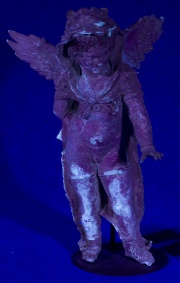Autofluorescence
Description
The ability of a material to fluoresce without the addition of any fluorochromes. Some organic and inorganic materials autofluoresce by absorbing energy from incident radiation then reemitting the radiation at a longer wavelength. The intensity and wavelength distribution of the emission can change as a material ages. Some typical autofluorescent colors are:
- Proteins or carbohydrates: bright white to pale yellow
- Linseed oil: green to yellow when fresh, intensity decreasing with age
- Dammar and Mastic: pale yellow to green, may be dark orange if oil is present
- Shellac: orange (varying shades depending on original color of shellac)
- Zinc white: whitish yellow
- Titanium dioxide or Lead white: deep purple
- Calcite: purple
- Indian yellow: bright yellow
- Polyethylene: whitish purple
- Cellulose nitrate: purple
Synonyms and Related Terms
primary fluorescence; autofluorescent
Additional Images
Resources and Citations
- Richard C. Wolbers, Nanette T. Sterman, Chris Stavroudis, Notes for Workshop on New Methods in the Cleaning of Paintings, J.Paul Getty Trust, Los Angeles, 1990 Comment: Source for most fluorescent colors in list
- G.Osmond "Accelerated Deterioration of Artists Oil Paints: An Assessment Involving Ultraviolet Fluorescence Microscopy" ICOM Preprints Washington 1993 p.239-247



